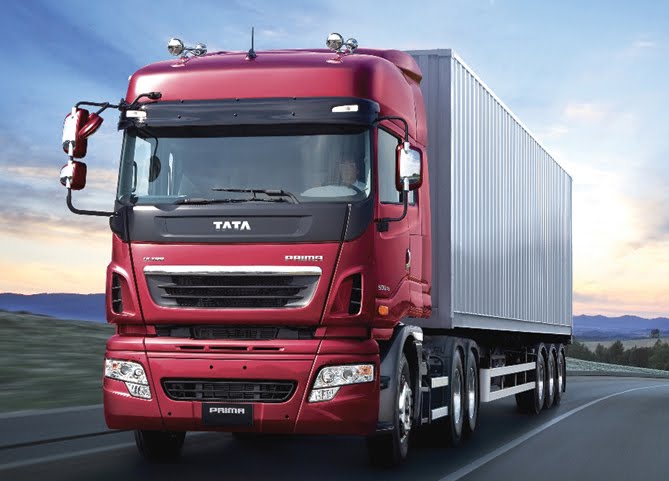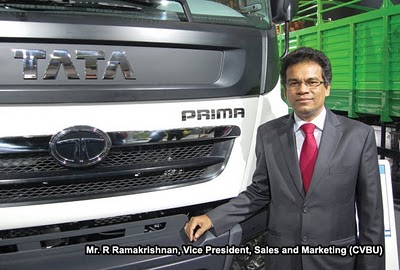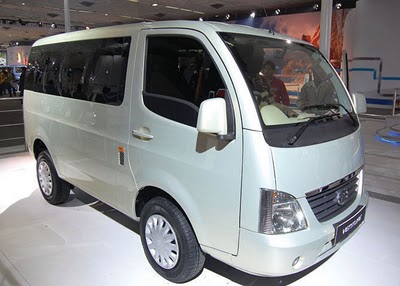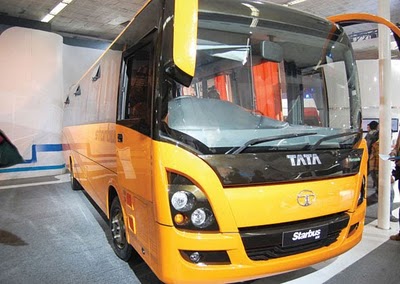To offer complete transportation solutions from 0.5 to 49 tonnes and above
 The pace of change at Tata Motors is breath taking, particularly in the commercial vehicles segment. The last few years saw the company developing a whole range of vehicles for both cargo and passenger applications right from 0.5 tonne to 49 tonne and above. On the one side, the company is test marketing Iris, a 0.5 tonner four-wheeled passenger vehicle, ideal for rural transportation and on the other hand, it is concept-selling the Prima range of heavy duty trucks. The versatility of Tata Motors is reflected in it is ability to identify the market opportunity in every segment and fill the gaps in its product portfolio to take advantage of the emerging opportunity.
The pace of change at Tata Motors is breath taking, particularly in the commercial vehicles segment. The last few years saw the company developing a whole range of vehicles for both cargo and passenger applications right from 0.5 tonne to 49 tonne and above. On the one side, the company is test marketing Iris, a 0.5 tonner four-wheeled passenger vehicle, ideal for rural transportation and on the other hand, it is concept-selling the Prima range of heavy duty trucks. The versatility of Tata Motors is reflected in it is ability to identify the market opportunity in every segment and fill the gaps in its product portfolio to take advantage of the emerging opportunity.
In an in-depth interaction with Mr. R Ramakrishnan, Vice President, Sales and Marketing (CVBU), Tata Motors, he shared lot of insights about the company’s plans right from launching new products to the changing trends in the Indian transportation industry and how Tata Motors is gearing up to take advantage of the emerging opportunities and much more to Motor India.
Ramakrishnan says: “The biggest advantage with Tata Motors is the in-depth understanding of the market and the range of products offered. Over a period of time, we believe that we will very quickly move from being a cowl chassis maker to a total transport solutions provider”.
According to Ramakrishnan, Tata Motors has lined up an array of products to be launched in the next 12 to 18 months. In the heavy truck segment, the company is planning to introduce the Prima range, with the launch of a 49 tonne tractor trailer model fitted with 280 hp engine, followed by a 31 tonne 8×4 tipper with 380 hp for mining applications, which will also be launched with a 280 hp engine. Further, the company also will launch a 49 tonner tractor trailer with 380 hp engine for ODC applications and subsequently a 25 tonne tipper with a 380 hp engine, again for mining applications.
Tata Motors has soft-launched Iris in Rajasthan and is planning to launch it in other markets shortly. Part of the Penquin project, Iris is a 0.5 tonner version of Tata Ace. “We had launched the passenger version initially and would soon introduce the goods carrier version as well. We always believed that the potential for a small passenger vehicle is immense in the country and we want to get into that segment in the first place”, Ramakrishnan pointed out.
While elaborating on another unique change that is going to take place in the Indian transportation industry, Ramakrishnan says: “There are many changes which one can expect, going forward. What with the kind of infrastructure development taking place, the new express ways and other major road projects, there is bound to be an excellent connectivity across the country. India will soon have six and eight lane highways and to take advantage of these infrastructure developments, the industry needs high horse power trucks which are ideal for long haul, especially carrying heavy loads.
This means, the composition of the truck market today, which is heavily skewed towards the rigid trucks or the three-axle trucks, will eventually move towards tractor trailer, which will suit long distance applications.
On the other side, the rigid trucks will come down to shorter distance like tippers or construction equipment and special cargo, which is of light density and subsequently less tonnage. What is more, these segments will move towards two-axle or three-axle truck with a longer wheel base. A few of these vehicles can be used as vehicle carriers such as car carriers, two wheeler and three wheeler carriers. Rigid trucks, on the other hand will be confined to these applications. Construction and mining applications will typically use the two, three and four axle tippers. Our aim is to shift towards higher horse power trucks”, Ramakrishnan adds.
There is a growing expectation for the power to weight ratios to go up, even within the city or inter-city. The trucks will have to keep pace with other vehicles on road failing which these vehicles will be a big cause for traffic congestion and instrumental in growing number of accidents.
Operational efficiency
Tata Motors is also laying lot of emphasis on improving the operational efficiency of its trucks. Typically, a truck in India does around 350 kilometres to 400 kilometres a day. The Prima range is touching 700 kilometres a day. “From the consignor’s point of view, his warehousing requirement on both ends and the inventory on wheels are cut down by half. Currently, the inventory cost is quite significant and we are looking at more powerful and efficient powertrains, which means the life of the vehicle, is not only longer, so does the improvement in reliability. A typical Indian truck works for about 230 days to 250 days in a year and the new range of Prima trucks can do up to 330 days in a year. That is the kind of change we are talking in terms of availability”, Ramakrishnan adds.
As manufacturers move towards offering ready-to-use, fully built vehicles which are application specific, there is a lack of efficient and good quality application providers in the country, Ramakrishan says and adds: “There is still a dearth for good quality application providers in India, not to mention the good quality manufacturers of tippers, trailers, bulkers and other applications. Initially, the OEMs will have to show the way and develop efficient and affordable bodies for their trucks. We firmly believe that in the next few years, fully built vehicles will gain prominence much more like in the developed world”.
Tata, as a group has built lot of expertise on the application side. TRF, one of the group companies has made a slew of acquisitions in the area of manufacturing axles, tippers and trailers. The company acquired York, a leading global axle manufacturer a few years ago. Moreover, TRF has recently acquired Dutch Lanka, a major trailer manufacturer and also bought out the stake in Aditya Automotive for building tippers. All this will eventually help build competence within the group, Ramakrishnan feels.
Lacuna in loading process
According to Ramakrishnan, yet another key change that is expected to happen is on the loading and unloading of goods. there is no use having high powered trucks, which can carry goods from one point to the other in half the time, but still end up spending hours waiting for loading and unloading the cargo.
Currently, there is lot of inefficiencies in the system. So, we need a more mechanised loading process in place. At the point of loading, what we require is a tailor-made loading ramp. Furthermore, we also need to move from a single tractor and trailer combination to a tractor with multiple trailer combination. For, this will considerably improve the productivity and further reduce the idle time, says Ramakrishnan.
Similarly, we are working on the unloading side as well. The unloading is usually done at a location where there is no proper infrastructure. This is where we need equipment like truck mounted cranes or evolve other concepts which are low cost, low investment, yet doing the job effectively”, he adds.
Ramakrishnan feels that Tata Motors need to get into these areas effectively. “When we say that we want to be a complete solution provider, all these elements need to be taken into account. We are actively working on various aspects such as training the drivers and mechanics, educating goods manufacturers on loading and unloading points and we are also actively engaged in all these developments right now”, Ramakrishnan avers.
Rural economy
“As far as the rural and semi-urban transportations are concerned, we believe some very big change is going to take place and that is where products like Iris are going to play a significant role”, Ramakrishnan points out.
The road development in rural areas is already happening and under the Grameen Sadak Yojana, a little over 30 percent of the roads planned are already in place. What is more, in each of these villages that are already in the loop, the consumption have gone up phenomenally. Therefore, vehicles like Tata Ace are ideal and are operating in these areas. The moment roads are there in place, people start traveling from their villages to nearby towns and cities and this is where vehicles like Iris would come into picture. So, we are going to see a phenomenal growth in those parts of the country, where connectivity is happening. The passenger or the bus segment is going to be much bigger”, he says.
Service
While touching upon the servicing aspects of the new generation of trucks, Ramakrishnan has this to say: “We have not only designed our trucks to ensure minimal service and repair by improving the reliability of our trucks and aggregates, but also changed the service intervals. A typical truck today requires oil change every two months. The new trucks will require oil change every six months. For gearbox and axles, the service interval is 80,000 kilometres. All this will help reduce the need for frequent visits to workshops”.
According to the official, Tata Motors have the largest service network in the country. In terms of workshop, the company has well over 2,000 touch points, which are Tata Motors dealers and authorised service stations, not including the garages which has its trained mechanics. There are about 8,000 outlets for supply of spares.
“We are also now equipping all the workshops to service the new generation of trucks. The new trucks have lot of electronics and whole lot of cabin. Hence training and upgrading their knowledge and skill sets in handling these trucks are very important”, Ramakrishnan adds.



